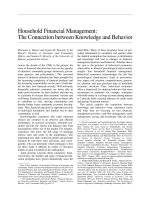Tài liệu Which Bank Is the “Central” Bank? An Application of Markov Theory to the Canadian Large Value Transfer System doc
Bạn đang xem bản rút gọn của tài liệu. Xem và tải ngay bản đầy đủ của tài liệu tại đây (321.61 KB, 20 trang )
Federal Reserve Bank of New York
Staff Reports
Which Bank Is the “Central” Bank?
An Application of Markov Theory to the
Canadian Large Value Transfer System
Morten L. Bech
James T. E. Chapman
Rod Garratt
Staff Report no. 356
November 2008
This paper presents preliminary findings and is being distributed to economists
and other interested readers solely to stimulate discussion and elicit comments.
The views expressed in the paper are those of the authors and are not necessarily
reflective of views at the Federal Reserve Bank of New York or the Federal
Reserve System. Any errors or omissions are the responsibility of the authors.
Which Bank Is the “Central” Bank? An Application of Markov Theory
to the Canadian Large Value Transfer System
Morten L. Bech, James T. E. Chapman, and Rod Garratt
Federal Reserve Bank of New York Staff Reports, no. 356
November 2008
JEL classification: C11, E50, G20
Abstract
Recently, economists have argued that a bank’s importance within the financial system
depends not only on its individual characteristics but also on its position within the
banking network. A bank is deemed to be “central” if, based on our network analysis,
it is predicted to hold the most liquidity. In this paper, we use a method similar to
Google’s PageRank procedure to rank banks in the Canadian Large Value Transfer
System (LVTS). In doing so, we obtain estimates of the payment processing speeds for
the individual banks. These differences in processing speeds are essential for explaining
why observed daily distributions of liquidity differ from the initial distributions, which
are determined by the credit limits selected by banks.
Key words: federal funds, network, topology, interbank, money markets
Bech: Federal Reserve Bank of New York (e-mail: ). Chapman:
Bank of Canada (e-mail: ). Garratt: University of California,
Santa Barbara (e-mail: ). The authors would like to thank Ben Fung,
Carlos Arango, Thor Koeppl, and Paul Corrigan for useful comments and suggestions.
The views expressed in this paper are those of the authors and do not necessarily reflect
the position of the Federal Reserve Bank of New York or the Federal Reserve System.
1 Introduction
Recently, economists have argued that the importance of banks within the
financial system cannot be determined in isolation. In addition to its individual
characteristics, the p osition of a bank within the banking network matters.
1
In
this paper we examine the payments network defined by credit controls in the
Canadian Large Value Transfer System (LVTS). We provide a ranking of LVTS
participants with respect to predicted daily liquidity holdings, which we derive
from the network structure. A bank is deemed to be “central” if, based on our
network analysis, it is predicted to hold the most liquidity.
2
We focus on the Tranche 2 component of the LVTS.
3
In this component,
participants set bilateral credit limits (BCLs) with each other that determine,
via these limits and an associated multilateral constraint, the maximum amount
of money any one participant can transfer to any other without offsetting funds.
Because banks start off the day with zero outside balances, these credit lim-
its define the initial liquidity holdings of banks.
4
However, as payments are
made and received throughout the day the initial liquidity holdings are shuffled
around in ways that need not conform to the initial allocation. Banks with high
credit limits granted to them may not be major holders of liquidity throughout
1
Allen and Gale (2000) analyze the role network structure plays in contagion of bank
failures caused by preference shocks to depositors in a Diamond-Dybvig type model and find
more complete networks are more resilient. Bech and Garratt (2007) explore how the network
topology of the underlying payment flow among banks affects the resiliency of the interbank
payment system.
2
We are, of course, departing from the standard designation of a country or countries’
principal monetary authority as the central bank. The Bank of Canada is the central bank of
Canada by that account. The proposed usage comes from the literature on social networks.
In this literature, the highest ranked node in a network is referred to as the central node.
3
See Arjani and McVanel (2006) for an overview of the Canadian LVTS.
4
This is not the case in all payment systems. In Fedwire op ening balances are with the
exception of discount window borrowing and a few accounting entries equal to yesterday’s
closing balance. In CHIPS each participant has a pre-established opening position require-
ment, which, once funded via Fedwire funds transfer to the CHIPS account, is used to settle
payment orders throughout the day. The amount of the initial prefunding for each partic-
ipant is calculated weekly by CHIPS based on the size and number of transactions by the
participant. A participant cannot send or receive CHIPS payment orders until it transfers
its opening position requirement to the CHIPS account.
1
the day if they make payments more quickly than they receive them. Likewise,
banks that delay in making payments may tie up large amounts of liquidity
even though they have a low initial allocation. Hence, knowledge of the initial
distribution alone does not tell us how liquidity is allocated throughout the
day, nor does it provide us with the desired ranking.
In order to predict the allocation of liquidity in the LVTS we apply a well
known result from Markov chain theory, known as the Perron-Frobenius theo-
rem. This theorem outlines conditions under which the transition probability
matrix of a Markov chain has a stationary distribution.
In the present application, we define a transition probability matrix for the
LVTS using the normalized BCL vectors for each bank. This approach is based
on the premise that money flows out of a bank in the proportions given by
the BCLs the bank has with the other banks. We also allow the possibility
that banks will hold on to money. This is captured by a positive probability
that money stays put. Assuming money flows through the banking system in a
manner dictated by our proposed transition probability matrix, the values of its
stationary vector represent the fraction of time a dollar spends at each location
in the network. This stationary vector is our prediction for the distribution
of daily liquidity. The bank with the highest value in the stationary vector
is predicted to hold the most liquidity throughout the day and is thus the
“central” bank.
An attractive feature of our application of Markov chain theory is that it
allows us to estimate an important, yet unobservable characteristic of banks,
namely, their relative waiting times for using funds. The Bank of Canada
observes when payments are processed by banks, but does not know when the
underlying payment requests arrive at the banks. We are able to estimate these
wait times using a Bayesian framework. We find that processing speed plays a
significant factor in explaining the liquidity holdings of banks throughout the
2
day and causes our ranking of banks to be different from the one suggested
by the initial distribution of liquidity. In particular, the bank which is central
based on initial liquidity holdings is not central in terms of liquidity flows over
the day.
Once we have estimates for the wait times we are able to see how well the
daily stationary distributions match the daily observed distributions of liquid-
ity. We find that they match closely. This validates our approach and suggests
that Markov analysis could be a useful tool for examining the impact of changes
in credit policies (for example a change in the system wide percentage) by the
central bank on the distribution of liquidity in the LVTS and for examining the
effects of changes in the credit policies of individual banks.
Our approach has much in common with Google’s PageRank procedure,
which was developed as a way of ranking web pages for use in a search engine
by Sergey Brin and Larry Page.
5
In the Google PageRank system, the ranking
of a web page is given by the weighted sum of the rankings of every other web
page, where the weights on a given page are small if that page p oints to a lot
of places. The vector of weights associated with any one page sum to one (by
construction), and hence the matrix of weights is a transition probability ma-
trix that governs the flow of information through the world wide web. Google’s
PageRank ranking is the stationary vector of this matrix (after some modifi-
cations which are necessary for convergence). In PageRank the main diagonal
elements of the transition probability matrix are all zeros. In contrast, we allow
these elements, which represent the probabilities that banks delay in processing
payment requests, to be positive.
The potential usefulness of Markov theory for examining money flows was
proposed by Borgatti (2005). He suggests that the money exchange process
5
The PageRank metho d has also been adapted by the founders of Eigenfactor.org to rank
journals. See Bergstrom (2007)
3
(between individuals) can b e modelled as a random walk through a network,
where money moves from one person to any other person with equal probabil-
ity. Under Borgatti’s scenario, the underlying transition probability matrix is
symmetric. Hence, as he points out, “the limiting probabilities for the nodes
are proportional to degree.” The transition probability matrix defined by the
BCLs and the patience parameters of banks is not symmetric and hence, this
proportionality does not hold in our application.
Others have looked at network topologies of banking systems defined by
observed payment flows. Boss, Elsinger, Summer, and Thurner (2004) used
Austrian data on liabilities and Soram¨aki, Bech, Arnold, Glass, and Beyeler
(2006) used U.S. data on payment flows and volumes to characterize the topol-
ogy of interbank networks. These works show that payment flow networks share
structural features (degree distributions, clustering etc.) that are common to
other real world networks and, in the latter case, discuss how certain events
(9/11) impact this topology. In terms of methodology our work is completely
different from these works. We prespecify a network based on fixed parameters
of the payment system and use this network to predict flows. The other papers
provide a characterization of actual flows in terms of a network.
2 Data
The data set used in the study consists of all Tranche 2 transactions in the
LVTS from October 1st 2005 to October 31st 2006. This data set consists of
272 days in which the LVTS was running.
The participants in the sample consist of members of the LVTS and the
Bank of Canada. For the purp oses of this study we exclude the Bank of Canada
since it does not send any significant payments in Tranche 2.
67
6
W
e discuss implications of this in section 3.
7
While we remove the Bank of Canada payments we do not remove the BCLs that the
4
BCLs abs diff
min 0.0 0.0
25 percentile 50.0 0.0
median 200.0 0.0
mean 417.3 59.5
75 percentile 698.6 16.3
max 2464.7 1201.1
std. dev. 495.8 182.5
Table 1: Daily cyclical limits in millions of Canadian dollars
2.1 Credit controls
The analysis uses data on daily cyclical bilateral credit limits set by the fourteen
banks over the sample period. Sample statistics for the daily cyclical limits are
presented in Table 1. BCLs granted by banks vary by a large amount (at least
an order of magnitude). The BCLs are fairly symmetric since the minimum
through the 50th percentile of absolute differences of the BCLs between pairs
of banks are zero and even the 75 percentile of the cyclical is only 16 million
compared to the average cyclical BCL of 699 million. While it is not evident
from table 1, BCLs vary across pairs of banks by a large amount (at least an
order of magnitude) in some instances.
3 Initial versus average liquidity holdings
Let W
t
denote the array of Tranche 2 debit caps (or BCLs) in place at time
t, where element w
ijt
denotes the BCL bank j has granted to bank i on date
t. The initial distribution of liquidity is determined by the bilateral debit caps
that are in place when the day begins. By taking the row sum of the matrix
W
t
, we obtain the sum of bilateral credit limits granted to bank i. However,
a bank’s initial payments cannot exceed this amount times the system wide
Bank of Canada grants to other banks in Tranche 2. As this would have an impact on the
T2NDCs between member banks.
5
percentage, 24% during the sample period.
8
Using the notation from Arjani
and McVanel (2006), let
T 2NDC
it
= .24 ∗
j
w
ijt
, (1)
denote the Tranche 2 multilateral debit cap of bank i on date t. Since we are
summing over the BCLs that each bank j = i has granted to bank i, this is
the conventional measure of the status (a l´a Katz (1953)) of bank i. The BCL
bank j grants to i defines i’s ability to send payments to j. Hence, in terms
of the weighted, directed network associated with W
t
, w
ijt
is the weight on the
directed link from i to j. Hence, T 2NDC
it
/.24 is also the (weighted) outdegree
centrality of bank i on date t.
The multilateral debit caps specified in (1) represent the amount of liquidity
available to each bank for making payments at the start of the day. Thus, the
initial distribution of liquidity on date t is d
t
= (d
1t
, , d
nt
), where
d
it
=
T 2NDC
it
n
j=1
T 2NDC
jt
, i = 1, , n.
During the day the liquidity holdings of bank i change as payments are sent
and received. The average amount of liquidity that bank i holds on date t,
denoted Y
it
, is the time weighted sum of their balance in Tranche 2 over the
day on date t and the maximum cyclical T2NDC on date t. To compute this
we divide the day into K
i
(not necessarily equal) time intervals, where K
i
is
the number of transactions that occurred that day for bank i. Then
Y
it
=
K
i
k
i
=0
p
k
it
δ
k
i
,k
i
+1
t
+ T 2NDC
it
(2)
where δ
k
i
,k
i
+1
t
is the length of time between transaction k
i
and k
i
+ 1 on date t
8
T
he system wide percentage is currently 30% and was changed on May 1st 2008.
6
and p
k
i
it
is i’s aggregate balance of incoming and outgoing payments on date t
following transaction k
i
.
In a closed system the aggregate payment balances at any point must sum
to zero across all participants. Therefore the total potential liquidity in the
system is the sum of the T2NDCs. In practice this is not quite true since the
Bank of Canada is also a participant in the LVTS and acts as a drain of liquidity
in Tranche 2. Specifically, the Bank of Canada receives payments on behalf of
various other systems (e.g. Continuous Linked Settlement (CLS) Bank pay-
ins). Therefore, in practice the summation of net payments across participants
sums to a negative number; since the Bank of Canada primarily uses Tranche
1 for outgoing payments. To account for this drain, we use as our definition of
liquidity in the system at any one time the summation, across all banks, of (2).
Thus, the average share of total liquidity that i has on date t is equal to
y
it
=
Y
it
14
i=1
Y
it
. (3)
The vector y
t
= (y
1t
, , y
nt
) is our date t measure of the observed average
liquidity holdings for the n banks.
A comparison of the initial liquidity holdings, d
t
, to the average liquidity
holdings, y
t
, over the 272 days of the sample period is shown in Figure 1. Each
point in the figure represents a matching initial and average value (the former
is measured on the horizontal axis and the latter is measured on the vertical
axis) for a given bank on a given day. Hence, there are 272 × 14 = 3808 points
on the graph. If the two liquidity distributions matched exactly, all the points
would lie on the 45 degree line.
The worst match between the average liquidity holdings and the initial
holdings o ccurs for points on the far right of Figure 1. This vertical clustering
below the 45 degree line reflects the fact that for some banks the value in the
7
0.00 0.05 0.10 0.15 0.20
0.00 0.05 0.10 0.15 0.20
Initial Distribution of Liqudity
Average Liquidity Holding
Figure 1: Initial versus average liquidity holdings.
initial distribution is almost always greater than the average liquidity holdings
over the day. This occurs because, as we shall see in section 5, these banks, in
particular bank 11, are speedy payment processors.
4 Markov Analysis
We begin with the weighted adjacency matrix W
t
defined from the BCLs in
Section 3 and normalize the components so that the rows sum to one. That is,
we define the stochastic matrix W
N
t
= [w
N
ijt
], where
w
N
ijt
=
w
ijt
j
w
ijt
. (4)
Row i of W
N
t
is a probability distribution over the destinations of a dollar that
leaves bank i that is defined using the vector of BCLs granted to bank i from
all the other banks on date t. Conditional on the fact that a dollar leaves bank
8
i, its movement is described by the matrix W
N
t
. However, we need to make
an important modification to address the fact that banks sometimes delay in
processing payment requests.
Delay is accounted for by (i) specifying delay probabilities θ
i
for each bank
i and (ii) re-scaling the off-diagonal elements of W
N
t
to make these the appro-
priate conditional probabilities. Specifically, we create a new stochastic matrix
B
t
= [b
ijt
], where
b
iit
= θ
i
, i = 1, , n, and b
ijt
= (1 − θ
i
)w
N
ijt
for i = j. (5)
The delay parameters θ
i
can be interpreted as the probability that bank i
sends a payment to itself. These are allowed to differ across banks, but not
across time. That is, the θ
i
’s are taken to be primitives of the payment process
(like preference parameters) and are assumed to be constant over the period of
analysis.
9
By the Perron-Frobenius theorem (see, for example, Seneta (1981, chapter
1) we know that the power method applied to the matrix B
t
converges to
a unique, positive stationary vector from any starting point so long as B
t
is
stochastic, irreducible and aperiodic. These conditions are met by construction
and because of the high degree of connectedness of banks in the LVTS.
10
Given
a vector of delay parameters θ = (θ
1
, , θ
n
), the desired stationary vector,
which we denote by x
t
(θ), is the leading (left) eigenvector of B
t
:
x
T
t
(θ) = x
T
t
(θ)B
t
. (6)
9
We discuss the implications of allowing the θ
i
’s to vary over time in Section 6.
10
In the case of Google, many pages exist which do not link to other pages and hence
the transition probability matrix constructed from the world wide web using links is only
substochastic. Moreover, this hyperlink matrix, as it is called in Langville and Meyer (2006),
is neither irreducible nor aperiodic. Hence, modifications of the initial hyperlink matrix are
required to derive the Google rankings.
9
Where do the θ
i
’s come from? Unfortunately data is available on when
payment requests are processed, but not on when they were first received by
the bank. Hence, we do not have data on the delay tendencies of each bank.
Consequently we estimate the delay parameters using our assumption that on
average the distribution of liquidity in the system throughout the day achieves
the stationary distribution that corresponds to the transition probability matrix
B
t
.
5 Estimation of the delay parameters
We want to choose the vector θ so that over the sample perio d the eigenvectors
defined by (6) are as close as possible to the observed distributions of average
liquidity.
5.1 Bayesian Estimation Procedure
Our model of the observable distribution of liquidity is
y
it
= x
it
(θ) + ǫ
it
, (7)
where θ is the vector of unknown diagonal parameters of B
t
, y
it
is the average
amount of liquidity held by bank i on date t, x
it
(θ) is the stationary amount
of liquidity held by i on date t according to (6), and ǫ
it
is the forecast error,
which has a mean zero symmetric distribution.
In this preliminary exploration we are interested in explaining mean levels
of liquidity as opposed to the forecast errors. Therefore, we assume a simple
distribution of errors that is independent across observations.
11
The process of
11
A plausible next step would be to include the correlations between the errors on a given
data t induced by the fact that the y
it
variables have to sum to one for each bank. Given
the difficulty in estimating the mean parameters, estimating these covariance parameters, as
well as accounting for heteroskedasticity, is left for a later exercise.
10
finding the unobservable θs can be done either via a GMM estimation or via a
Bayesian framework; the latter is described below.
The family of distributions used for the forecast error is the normal family
with precision τ.
12
In this case the likelihood for an observation is
L(y
it
|θ, B
t
, τ) = N(y
it
|x
it
(θ), τ).
Assuming independence of the errors, a likelihood for the whole sample is
L({y
it
}
T
t=1
|θ, {B
t
}
T
t=1
, τ) =
T
t=1
n
i=1
L(y
it
|θ, B
t
, τ).
We assume a flat uniform prior on the θs and a diffuse Gamma prior on
the precision with a shape parameter of 1/2 and a scale parameter of 2. The
former distribution embodies our lack of information about the θs and the
latter distribution embodies our lack of information of the error term, and also
exploits the conjugacy of the normal-gamma likelihood. The natural question
is how diffuse are the priors used. A natural accounting for this would be to
use a Jefferys prior. In our case this is impossible since this requires taking the
Hessian of the functioning mapping the θs to an eigenvalue. That being the
case we think a uniform prior on the interval [0, 1] is suitable uninformative for
our purposes.
The MCMC algorithm used to calculate the above model is a Metrop olis-
in-Gibbs. The first blo ck is a draw of τ (conditional on the current realization
of the θs) from its posterior distribution of Gamma with the scale parameter
of 1/2+nT where nT is the total number observations, and a shape parameter
of 1 + SSE where SSE is the sum of squared errors (i.e the sum of squared
differences between the cash distribution and the stationary distribution). The
second block is a random walk Metropolis-Hastings step to draw a realization
12
T
he precision is just the inverse of the variance.
11
of the θs conditional on the current realization of τ. The proposal density is a
multivariate normal distribution with mean of the current θs and a covariance
matrix tuned so that the acceptance probability is approximately 25%-30%.
The drawing procedure consists of simultaneously drawing the mean of the
θs, which is denoted
¯
θ, and then drawing deviations of this mean, which are
denoted θ
ǫ,i
. An individual θ is then defined as
θ
i
=
¯
θ + θ
ǫ,i
,
i = 1, , n. This allows good movement along the likelihood surface as de-
scribed by Gelman and Hill (2007).
6 Empirical results
The algorithm was started at θ
i
equal to 0.5 for all banks except for bank
eleven which was set at (roughly) 0.3. After this, the MCMC algorithm was
run for 530,000 iterations and a posterior sample was collected.
13
The first
30,000 iterations were discarded as a burn-in phase. Total computing time was
roughly 84 hours.
The posterior sample averages and the 95% Highest Probability Densities
(HPDs) are presented in Table 2. Precise estimates of θ have a fairly large
amount of uncertainty to them. This is due to an identification problem in
how the θ’s are defined. If all θs are identical (say zero), then the stationary
distribution that comes from this set of θ’s will b e the same as that from any
other identical vector of θs. This holds for the case when all θ’s are identical
and not equal to one. Another issue is that the surface of the likelihood is
very flat in certain directions (e.g. the direction of the unit vector) and falls off
rapidly in other directions. Because of this the sampler can only move slowly
13
T
he identification problems discussed below necessitated the large amount of iterations.
12
Bank θ
i
Lower 95% HPD Upper 95% HPD
1 0.3126 0.2396 0.4538
2 0.2285 0.0178 0.4632
3 0.3305 0.2580 0.4682
4 0.3251 0.2344 0.4677
5 0.4220 0.0357 0.7454
6 0.3815 0.0809 0.6019
7 0.1992 0.0921 0.3671
8 0.3348 0.2611 0.4721
9 0.4131 0.3400 0.5359
10 0.4154 0.3504 0.5369
11 0.0778 0.0021 0.2649
12 0.3591 0.2867 0.4923
13 0.4158 0.3222 0.5438
14 0.4962 0.4287 0.6015
Table 2: Posterior Averages
around the surface of the likelihood.
14
The most striking feature of the data presented in Table 2 is the degree
of heterogeneity among the estimates. Looking at the most extreme case we
see that bank 14 is on average over 6 times more likely to delay in making
a payment than bank 11. To date there are no theories that explain why
some banks would process payments more quickly than others. And, we do
not attempt to explain the variation in the θ
i
’s here. However, we do note
that there does seem to exist a negative relationship between delay tendencies
and initial liquidity holdings. Classical ordinary least squares regression of
the average initial distribution of liquidity for the fourteen banks on the θ
i
s
provides estimates of .4056 for the intercept (standard deviation equals 0.0472)
and -0.9669 for the slope (standard deviation equals 0.5442). This suggests
that banks with higher liquidity holdings delay less, however this is not quite
significant at the 10% confidence level (The p-value of the slope of the trend
line is .1009).
14
This is a problem of the likelihood not the method. In a classical exercise, like GMM,
the optimizer would get stuck at non-optimal points since as the optimizer gets close to (for
example) the unit vector it will stop moving (or slow down in its movements) due to the
flatness.
13
The broad range in the estimates of the θ
i
’s are produced by the Bayesian
estimation procedure in order to resolve differences between the initial distribu-
tions of liquidity and the average daily liquidity. We already saw a snapshot of
these differences in Figure 1. These differences are also reflected in the rankings
of the banks according to initial versus average liquidity holdings. Bank 11 had
the highest initial liquidity of all banks on 265 days of the sample period (272
days), but it had the highest average liquidity on only 5 days. In contrast, bank
1 had the highest initial liquidity of all banks on only 4 days, but it had the
highest average liquidity on 260 days. From Table 2 we see that bank 11 has a
delay parameter of only .0778 compared to .3126 for bank 1. Hence, despite its
relatively lower level of initial liquidity bank 1 is over 4 times more likely to hold
onto liquidity sent to it than bank 11, and hence bank 1 holds more liquidity
over the course of the day. Returning to the Sutton epigraph, suppose that on
some random day at some random time that Willie could steal the liquidity
from one of the fourteen banks in the LVTS.
15
Which bank should Willie rob?
An important message of this paper is that it is not the “central” bank in the
sense of Katz (1953) (i.e., the one with the highest initial liquidity). Rather, it
is necessary to factor in processing speeds which, until now, were unknown.
Figure 2 shows a boxplot of the average stationary distribution of liquidity
over the sample period, computed using our transition probability matrices B
t
specified in (5) and our posterior averages for the delay parameters specified in
Table 2. Each individual box covers the middle half (25% to 75% percentiles)
of a bank’s liquidity holdings according to the 272 stationary distributions we
computed over the sample period. The line in the middle of the box repre-
sents the median value. The whiskers from a given box extend to the most
extreme non-outlying observation (i.e. an observation less then 1.5 times the
15
This is, of course, a purely hypothetical question since liquidity in the system is in the
form of electronic balances rather than cash and Willie Sutton died in 1980.
14
1 2 3 4 5 6 7 8 9 10 11 12 13 14
0.00 0.05 0.10 0.15
Figure 2: Boxplot of the average stationary distribution of liquidity for banks
in the LVTS.
length of the given box). Observations beyond the whiskers are individually
plotted.
16
Our centrality predictions coincide with our declarations of the high-
est ranked banks according to observed (average) liquidity holdings. Bank 1
has the highest predicted liquidity according to the stationary distribution and
is thus central on 260 of 272 days, bank 3 is the central bank on 7 days and
bank 11 is central on the remaining 5 days.
An alternative approach would be to assume that the θ’s vary by day; since
it could be argued that θ captures both processing speed and other unobserved
factors.
17
One way to implement this would be to find the θ vectors that fit
the distribution exactly each day and look at the resulting time series of the
θ’s. Preliminary work on this shows that the averages of these time series are
comparable to the above posterior averages and that no discernible pattern of
dependence across days is apparent.
16
Assuming normality 1.5 times the interquartile range is roughly 2 standard deviations.
17
We thank Thor Koeppl for pointing this out.
15
6.1 Comparison of the stationary distribution to the ob-
served distribution of liquidity.
Figure 3 shows the daily stationary distributions (using the posterior means
for the θ vector) and the observed average liquidity distributions over the 272
days of the sample period.
18
Each point in the figure represents a matching
stationary distribution value and observed value (the former is measured on
the horizontal axis and the latter is measured on the vertical axis) for a given
bank on a given day. Different colors represent different banks. As in Figure 1,
there are 3808 points on the graph and if the two distributions matched exactly
all the points would lie on the 45 degree line.
Compared to Figure 1, which involves the initial distribution of liquidity,
there is improved clustering around the 45 degree line. In particular, the cluster
of points associated with the fastest processor, bank 11, (magenta) is centered
closely on the 45 degree line. In Figure 1 bank 11 was one of the several banks
which contributed to the vertical clustering below the forty-five degree line.
This was due to the fact that in Figure 1 the speed with which bank 11 (among
others) processes payments was not taken into account.
7 Conclusion
In this paper we have developed an empirical measure of which banks in the
Canadian LVTS payment system are likely to be holding the most liquidity
at any given time. This measure is based on the implicit network structure
defined by the BCLs that LVTS members grant each other.
Our measure of predicted daily liquidity holdings is based on the idea that
credit limits are a good indicator of likely liquidity flows. This idea is borne
18
An animated presentation of the data is available at
/>16
0.00 0.05 0.10 0.15 0.20
0.00 0.05 0.10 0.15 0.20
Stationary Distribution
Average Liquidity Holding
Figure 3: Observed liquidity and the stationary distribution at the posterior
average values of θ.
out by comparing predicted liquidity with the realized average liquidity. One
crucial parameter that we estimate is an unobserved processing speed param-
eter. We show that when processing speed is taken into account our measure
of predicted liquidity is a good predictor of daily average liquidity holdings.
Ignoring differences in processing speed leads to poorer predictions of average
liquidity.
References
Allen, F., and D. Gale (2000): “Financial Contagion,” Journal of Political
Economy, 108(1), 1–33.
Arjani, N., and D. McVanel (2006): “A
Primer on Canada’s Large Value Transfer System,”
17
neville.pdf.
Bech, M. L., and R. Garratt (2007): “Illiquidity in the Interbank Pay-
ment System following Wide-Scale Disruptions,” Staff Reports from Federal
Reserve Bank of New York, No. 239.
Bergstrom, C. (2007): “Eigenfactor: Measuring the Value and Prestige of
Scholarly Journals,” C&RL News, 68(5).
Borgatti, S. P. (2005): “Centrality and Network Flow,” Social Networks,
27(1), 55–71.
Boss, M., H. Elsinger, M. Summer, and S. Thurner (2004): “An Em-
pirical Analysis of the Network Structure of the Austrian Interbank Market,”
Oesterreichesche Nationalbank’s Financial stability Report, 7, 77–87.
Gelman, A., and J. Hill (2007): Data Analysis Using Regressionand Mul-
tilevel/Hierarchical Models. Cambridge University Press.
Katz, L. (1953): “A New Status Index Derived from Sociometric Analysis,”
Psychometrika, 18, 39–43.
Langville, A. N., and C. D. Meyer (2006): Google’s PageRank and Be-
yond: The Science of Search Engine Rankings. Princeton University Press.
Seneta, E. (1981): Non-negative Matrices and Markov Chains. Springer-
Verlag.
Soram
¨
aki, K., M. L. Bech, J. Arnold, R. J. Glass, and W. E.
Beyeler (2006): “The Topology of Interbank Payment Flows,” Staff Re-
ports from Federal Reserve Bank of New York, No. 243.
18









